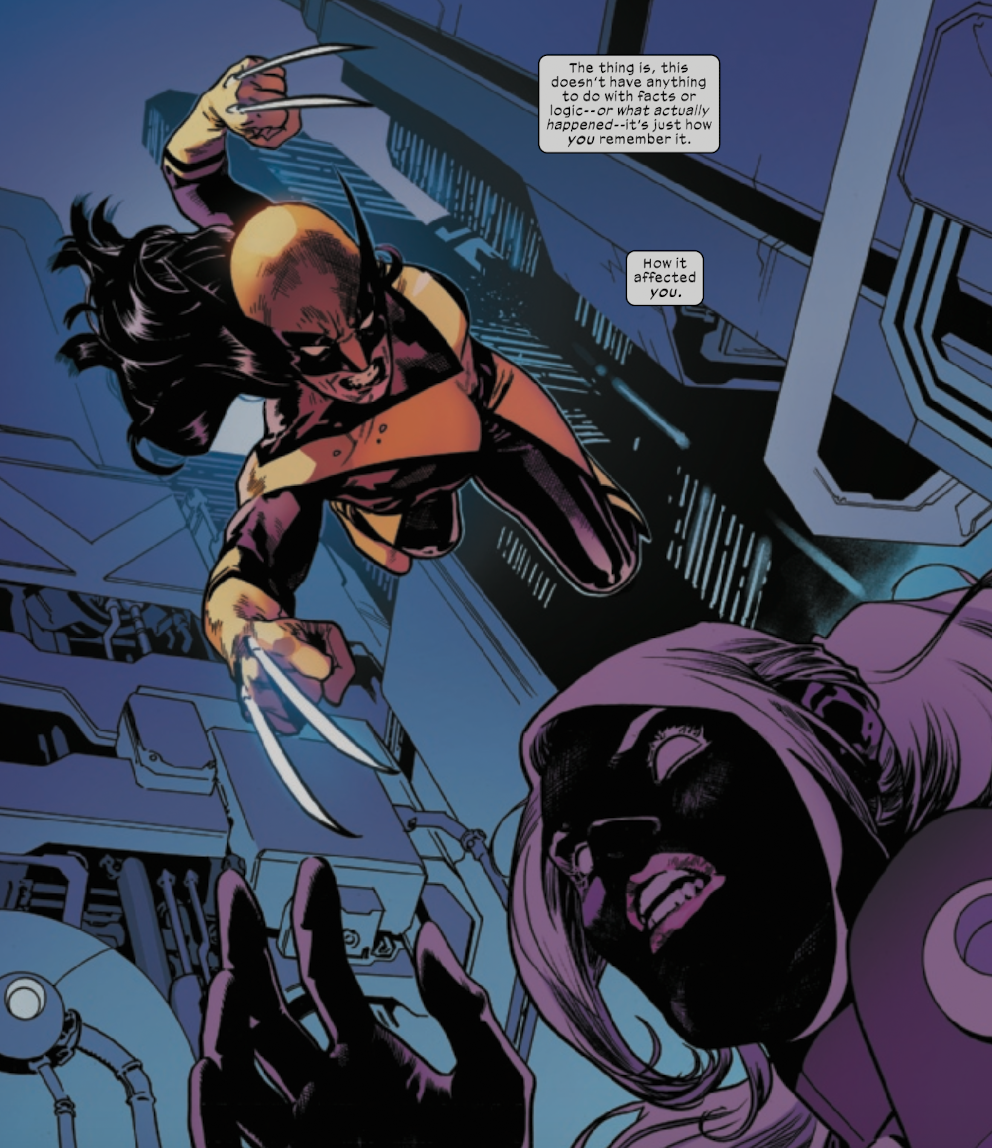Out Of The Vault
“Out of the Vault”
X-Men #19
Written by Jonathan Hickman
Art by Mahmud Asrar
Color art by Sunny Gho
• In all the time I was wondering how Jonathan Hickman would depict thousands of years passing in a single issue the obvious thing – the thing he chose to do – never occurred to me: A timeline similar to the way he mapped out the lives of Moira MacTaggert in House of X. It’s very effective in condensing the story while offering some intriguing details, and in keeping the focus of the issue on Synch’s experience in The Vault and the close emotional bond he forms with X-23 along the way. The balance of emotional weight, hard sci-fi, and narrative density is Hickman at his finest, and X-Men #19 is one of his best issues of this volume so far, probably second only to the Mystique-centric story “Oracle” from X-Men #6.
• Back at the start of this storyline in X-Men #5 when we’re introduced to Synch, we’re reminded in the text pages that his resurrection has put him in an awkward situation as all of his friends from the Generation X comic have moved on with their lives while he’s re-entering life a few years behind them. On the other side of his mission in the Vault he’s in an even stranger situation, having lived far beyond one life entirely removed from everyone but X-23 and Darwin, and now he’s the only one who remembers their time together. It’s a strange sort of tragedy, but because Synch is a fairly optimistic character, the issue ends on a hopeful rather than maudlin note that directly echoes his cautious optimism going into the Vault with X-23.
Hickman has clearly made it a mission to spotlight characters from Generation X out of personal affection for them, but what he does for Synch in this story goes beyond merely giving an old character from prime airtime. Synch, a character who has been absent from publication for 20 years, is both refined and redefined in this story – the essential Good Dude Romantic Lead elements of his personality are unchanged, but the circumstances of his experience are now unique and fascinating. From here on out he’s an old man in a young man’s body, a seasoned veteran who is now the mutant nation’s living repository of information about what could be their greatest existential threat. He’s now a narrative mirror of Moira MacTaggert, embarking on his third life and carrying the full knowledge of past lives like precious cargo. (Also, like Moira in Powers of X, he owed the extension of his life to borrowing the powers of a Wolverine.)
• We learn quite a bit about the Children of the Vault in this issue, and get a sense of how a deliberate technological approach to evolutionary development differs from the natural processes that result in mutantdom. It’s all quite advanced and there’s every indication that the existence of the Children and the Vault is part of some larger plan, but we are totally in the dark on whose plan it is. This issue makes it clear that Orchis is not responsible for the Vault, though they are aware of it and have captured and dissected Children. (Serafina of the Children was rescued along with several mutants from Orchis custody in X-Men #1.)
It seems probable that Orchis may co-opt the Children at some point in the story, but for now it’s a whole other situation. I suspect the mystery of who created Homo Novissima may be equivalent to the mystery of Rabum Alal that runs through Hickman’s Avengers run and culminated in one of the best reveals in that story.
• Aside from a brief cameo from Cyclops and Charles Xavier at the end of this issue, this two-part story is notable for being entirely focused on post-Chris Claremont cast and ideas. Synch was introduced in 1994, everything else in the Vault story was created in the 21st century. It’s fun to imagine what an X-Men reader in the ‘80s might make of this story if you could somehow send these two issues back in time. The most recognizable element would be a female version of Wolverine!
• Synch looks great with a bald head and beard, by the way. Mahmud Asrar did a fabulous job in aging him up along with X-23 and Darwin. Asrar did a typically fantastic job on this issue, it’s too bad this is apparently his last issue of the series for the foreseeable future.
• We don’t really have conclusive evidence that X-23 and Darwin died in the Vault, so it’s quite possible those versions of the characters are still in the custody of the Children and their powers of survival and infinite adaptation will be integrated into future generations of Children. Bleak!








